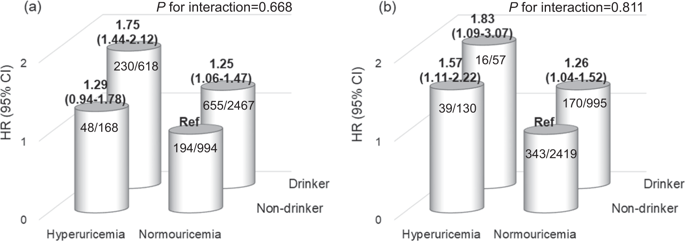当前位置:
X-MOL 学术
›
Hypertens. Res.
›
论文详情
Our official English website, www.x-mol.net, welcomes your
feedback! (Note: you will need to create a separate account there.)
Hyperuricemia predicts the risk for developing hypertension independent of alcohol drinking status in men and women: the Saku study
Hypertension Research ( IF 4.3 ) Pub Date : 2019-11-27 , DOI: 10.1038/s41440-019-0361-0 Yukako Tatsumi 1, 2, 3 , Kei Asayama 1, 4 , Akiko Morimoto 5 , Michihiro Satoh 6 , Nao Sonoda 5 , Naomi Miyamatsu 3 , Yuko Ohno 7 , Yoshihiro Miyamoto 2 , Satoshi Izawa 8 , Takayoshi Ohkubo 1, 4
Hypertension Research ( IF 4.3 ) Pub Date : 2019-11-27 , DOI: 10.1038/s41440-019-0361-0 Yukako Tatsumi 1, 2, 3 , Kei Asayama 1, 4 , Akiko Morimoto 5 , Michihiro Satoh 6 , Nao Sonoda 5 , Naomi Miyamatsu 3 , Yuko Ohno 7 , Yoshihiro Miyamoto 2 , Satoshi Izawa 8 , Takayoshi Ohkubo 1, 4
Affiliation

|
Hyperuricemia has been reported to be a risk factor for hypertension, but this association may be affected by alcohol consumption. This study aimed to investigate whether hyperuricemia remains a risk factor for hypertension after eliminating the effect of alcohol consumption. This study comprised 7848 participants (4247 men and 3601 women) aged 30–74 years without hypertension who had undergone a medical checkup between April 2008 and March 2009 at Saku Central Hospital, Nagano Prefecture, Japan. Hyperuricemia was defined as uric acid >7.0 mg/dl in men, ≥6.0 mg/dl in women, and/or receiving treatment for hyperuricemia or gout. The incidence of hypertension was defined as the first diagnoses of blood pressure ≥140/≥ 90 mmHg and/or initiations of antihypertensive drug treatment. Multivariable-adjusted hazard ratios (HRs) of hyperuricemia for the incidence of hypertension after adjustment for and classification by alcohol consumption were estimated using the Cox proportional hazard model. During a mean of 4.0 years of follow-up, 1679 individuals developed hypertension. After adjustment for alcohol consumption, the HRs (95% confidence interval) associated with hyperuricemia were 1.37 (1.19–1.58) in men and 1.54 (1.14–2.06) in women. Among nondrinkers, the HR was 1.29 (0.94–1.78) in men with hyperuricemia compared with men without, and the corresponding HR was 1.57 (1.11–2.22) in women. The corresponding HR was 1.88 (1.27–2.86) in all participants with baseline blood pressure <120/80 mmHg. The interactions between hyperuricemia and sex ( P = 0.534) and between drinking and sex ( P = 0.713) were not significant. In conclusion, hyperuricemia predicts the risk for developing hypertension independent of alcohol drinking status.
中文翻译:

高尿酸血症可预测与男性和女性饮酒状况无关的高血压风险:Saku 研究
据报道,高尿酸血症是高血压的危险因素,但这种关联可能受到饮酒的影响。本研究旨在探讨在消除饮酒影响后,高尿酸血症是否仍然是高血压的危险因素。该研究包括 7848 名年龄在 30-74 岁之间的无高血压参与者(4247 名男性和 3601 名女性),他们于 2008 年 4 月至 2009 年 3 月在日本长野县佐久中央医院接受了体检。高尿酸血症定义为男性尿酸>7.0 mg/dl,女性≥6.0 mg/dl,和/或接受高尿酸血症或痛风治疗。高血压的发生定义为首次诊断出血压≥140/≥90 mmHg 和/或开始抗高血压药物治疗。使用 Cox 比例风险模型估计高尿酸血症对饮酒量调整和分类后高血压发病率的多变量调整风险比 (HR)。在平均 4.0 年的随访期间,1679 人患上了高血压。调整饮酒后,与高尿酸血症相关的 HR(95% 置信区间)在男性中为 1.37(1.19-1.58),在女性中为 1.54(1.14-2.06)。在不饮酒者中,与不饮酒的男性相比,高尿酸血症男性的 HR 为 1.29 (0.94-1.78),女性相应的 HR 为 1.57 (1.11-2.22)。在所有基线血压 <120/80 mmHg 的参与者中,相应的 HR 为 1.88 (1.27–2.86)。高尿酸血症与性别( P = 0.534)和饮酒与性别( P = 0.713)之间的相互作用不显着。
更新日期:2019-11-27
中文翻译:

高尿酸血症可预测与男性和女性饮酒状况无关的高血压风险:Saku 研究
据报道,高尿酸血症是高血压的危险因素,但这种关联可能受到饮酒的影响。本研究旨在探讨在消除饮酒影响后,高尿酸血症是否仍然是高血压的危险因素。该研究包括 7848 名年龄在 30-74 岁之间的无高血压参与者(4247 名男性和 3601 名女性),他们于 2008 年 4 月至 2009 年 3 月在日本长野县佐久中央医院接受了体检。高尿酸血症定义为男性尿酸>7.0 mg/dl,女性≥6.0 mg/dl,和/或接受高尿酸血症或痛风治疗。高血压的发生定义为首次诊断出血压≥140/≥90 mmHg 和/或开始抗高血压药物治疗。使用 Cox 比例风险模型估计高尿酸血症对饮酒量调整和分类后高血压发病率的多变量调整风险比 (HR)。在平均 4.0 年的随访期间,1679 人患上了高血压。调整饮酒后,与高尿酸血症相关的 HR(95% 置信区间)在男性中为 1.37(1.19-1.58),在女性中为 1.54(1.14-2.06)。在不饮酒者中,与不饮酒的男性相比,高尿酸血症男性的 HR 为 1.29 (0.94-1.78),女性相应的 HR 为 1.57 (1.11-2.22)。在所有基线血压 <120/80 mmHg 的参与者中,相应的 HR 为 1.88 (1.27–2.86)。高尿酸血症与性别( P = 0.534)和饮酒与性别( P = 0.713)之间的相互作用不显着。









































 京公网安备 11010802027423号
京公网安备 11010802027423号